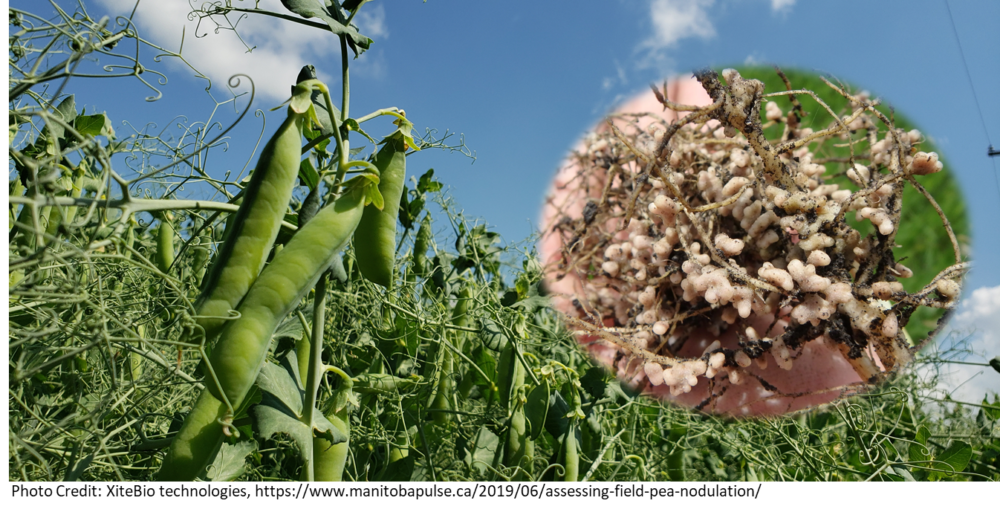Snow is beginning to fall across a lot of the Canadian prairies and with harvest 2020 mostly in the books it is a good time of year to begin thinking about your fertility plans for the upcoming season. Inoculants are a major part of any pulse grower’s fertility plan and with pulse acres on the rise here in Canada it is an optimal time to get some tips about the best way to maximize next season’s pulse crops. Inoculation is an easy and field-friendly way to put Mother Nature to work for your crop. Inoculants utilize nitrogen (N) from the air and actually put N back into the soil via crops. Nitrogen fertilizers are expensive, so the less you need to purchase and apply to your field, the better. Pulses can get up to 90% of their required N from N-fixing bacteria and may not require any starter fertilizer applications (1).
Firstly, make sure you purchase an inoculant specific to your crop. There are several species of N-fixing bacteria that form symbiotic relationships with plants, but each crop has a specific bacteria species that forms nodules with it. For peas lentils, and faba beans, this is Rhizobium leguminosarum. Make sure you are using an inoculant that is suitable for your intended crop, as this is a must for successful nodulation.
When inoculating, your ultimate goal is to achieve maximum effective nodulation on your crop’s roots. Inoculating properly will achieve this nodulation and in turn optimize the N-fixation by rhizobia. But not all nodules are created equal. There are two types of nodules that can form on roots: crown nodules and lateral nodules. Crown nodules form at the crown of the root mass and are more prevalent in roots that were inoculated as a seed treatment. Lateral nodules develop on lateral roots and are more prevalent with in-furrow (granular or liquid) inoculant applications or when naturally occurring bacteria are already present in soil. Crown nodules develop earlier than lateral nodules, and because of this they are of more value in early development. Getting nodulation established early means N gets to your crop sooner and prevents any plant malnutrition due to a lack of N (2).
How you apply your inoculant can be just as important as the inoculant itself and there are some common issues you should be aware of during this process. Granular inoculants can bridge in the hopper and stop being applied, leading to uninoculated areas and time spent reapplying. Even after granular inoculants are applied, it can be blown around on a windy seeding day, affecting your application. Liquid inoculants, however, go on evenly and fully coat the seed being treated. Liquid inoculants can also be applied uniformly and consistently during in-furrow application. Because liquid inoculants have direct contact with other seed treatments/crop inputs during both in-furrow and seed treatment application, you must ensure they are compatible with any other chemicals you are using. Consult your inoculant manufacturer’s compatibility information before using (1).
Getting the most out of your pulse inoculant is as simple as choosing the right product and closely following the manufacturer’s recommendations for storage and application. Inoculants contain living, breathing bacteria and ensuring they are well taken care of before & during application is very critical. Nodules take about 4-6 weeks after seeding to develop, so checking your plants for nodulation after this time is recommended. If you see active nodules, your crop is in good condition. Cutting open a few nodules to check for colour can ensure that N is being fixed. If nodules are a pale pink/red color, N fixation is occurring (active & proper nodulation). If nodules are pale white or grey or greenish, they are not effective (3).
References:
- https://saskpulse.com/files/general/160401_Nitrogen_management_for_pulses2.pdf
- https://www.saskatchewan.ca/business/agriculture-natural-resources-and-industry/agribusiness-farmers-and-ranchers/crops-and-irrigation/soils-fertility-and-nutrients/nodulation-and-nitrogen-fixation-field-assessment-guide
- https://saskpulse.com/files/technical_documents/180704_Top_Dressing-compressed.pdf


